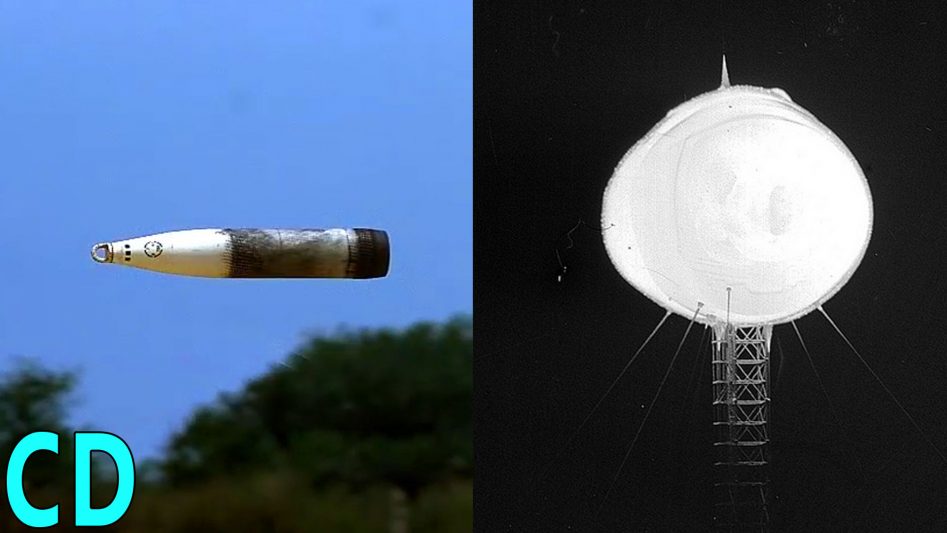In my last video I looked railguns, now whilst I was reviewing the footage I started wondering how they filmed the projectiles in flight. These were not a typical high-speed cameras shots like a bullet hitting a target, for example, these track the projectile from the barrel and down the firing range.
From the footage, it looks like the camera is panning around and following the projectile but that would be impossible, the tank round is travelling at over 1500m per second and would normally look like this.
For all of you out there who said it was done with mirrors then you are absolutely correct. It works by having a computer controlled high speed rotating mirror in the line of sight of a high-speed camera. The speed of the rotation of the mirror matches that of the object being followed, so the faster the object is travelling like a railgun projectile, the faster the mirror would turn to keep up with it.
Using this method, the object can be kept in the field of view for 100m or so of travel and about 90 degrees of the mirrors movement. In this example, the Tracker2 from specialised-imaging you can see the mirror and then to the left is the camera. Because the mirror is computer controller it can be programmed to follow objects that accelerate either linearly or non linearly.
Rotating mirror cameras aren’t new, in fact, that were some of the first and are still some of the fastest cameras in the world capable of up to 25 million frames per second and were used to record atom bomb tests.
During the Manhattan project to develop the first atomic bomb, they required cameras that could record the first few microseconds of the explosion. In order to create the nuclear chain reaction and achieve critical mass, a baseball sized piece of plutonium had to be compressed to about half its size. This was achieved using an array of focused high explosive lenses surrounding the plutonium core.
In order to make it work effectively the explosives, 32 in all had to be triggered within 1 microsecond, if any were delayed then the compression of the core would be unequal and the reaction would be much less or may not even happen at all.
Using a super high-speed camera it would be possible to see the how effective the explosive lenses had been, just a few microseconds after detonation.
At the time the fastest cameras were Fastax cine cameras and could achieve about 10,000 frames per second or one frame per 100 microseconds. This still wasn’t fast enough.
The first high speed rotating mirror camera was the Marly. Invented by a British physicist William Gregory Marley. The Marley camera used a rotating mirror and an array of lenses inside a curved housing each focused on to a single piece of film around the edge of the case. This could record a sequence of 50 images on to 35mm film at 100,000 frames per second. But by the time of the Trinity test it was outdated and too slow to record the ultra quick reaction in the plutonium core which was in the region of 35ns.
Head of the photography unit, Julian Mack said that “the fixed short focus and low quality of the lenses would probably have made the Marley camera pictures useless”.
He helped develop the Mack Streak Camera, which had a 10 million frame per second limit, one frame every 100 nanoseconds.
By the 1950’s, Harold Egerton developed the Rapatronic camera, the name coming from Rapid Action Electronic. This used a magneto-optic shutter which allowed it have an exposure time as short as 10ns, that’s 10 billionths of a second. This was first used for the Hydrogen bomb test at Eniwetok atoll in 1952. However they only took one image at a time, so to see the first few microseconds of an atomic detonation, up to ten were used in sequence with average exposure times of 3 microseconds. The images were then played back and blended together to give the impression of the film.
For the British nuclear tests, the Atomic Weapons Research Establishment created the C4, a huge rotating mirror camera weighing in at 2000kg and was the fastest in the world at the time. This could record up to at 7 million frames per second with the mirror rotating at up to 300,000 rpm and recorded the first British atom bomb on 3rd October 1952.
The rotating mirror cameras are still in use today but they now use High sensitivity CCD’s to replace the film strip. The Brandaris 128 and Cordin Model 510 have 128 CCDs and a gas driven turbine mirror driven by helium to achieve up to 25 million frames per second at a resolution of 500×292 pixels for the Brandis and 616 x 920 for the Cordin.
At 25 million frames per second, the mirror itself running at 1.2 million revolutions per minute, that’s 20,000 revolutions per second, so fast that the atmosphere inside the camera is 98% helium to reduces the friction and pressure waves that would occur with normal air.
And so on to something which I think you may find rather interesting. It’s not the fastest camera in the world but this one is, or was at the time in 2013, the fastest realtime tracker of a moving object and was developed by the Ishikawa Oku lab at University of Tokyo.
Here it is tracking a ping pong ball and keeping it in the centre of the frame at all times, both during a game and when it is being spun around on a piece of string.
It does this by moving two mirrors in front of the camera, one for the X movement and the other for the Y movement. It then uses software similar to face tracking to provide feedback to control the mirrors with a response time of just 1 millisecond. It can also be used to control a projector, and in these scenes, it is projecting an image on to the Ping-Pong ball whilst it’s being bounced on the bat, you can see the little face change on the ball at the top of its travel.
Anyways, I hope you enjoyed this look at some the equipment behind some of the most amazing footage recorded to date, these aren’t the fastest cameras in the world now but still amazing to think what you can achieve by mechanical means.






Comments
Hey Curious Droid, enjoyed your video on high speed filming…. Check this video out, filming photons of light…https://youtu.be/snSIRJ2brEk
….One more you might like, https://youtu.be/W9xzU0xjlhE
Can you have a video on Carl Sagan’s scientific contributions?
Other videos on the topics of other worlds (Mars’ atmosphere and so on) are appreciated.
Love your work, keep it up!